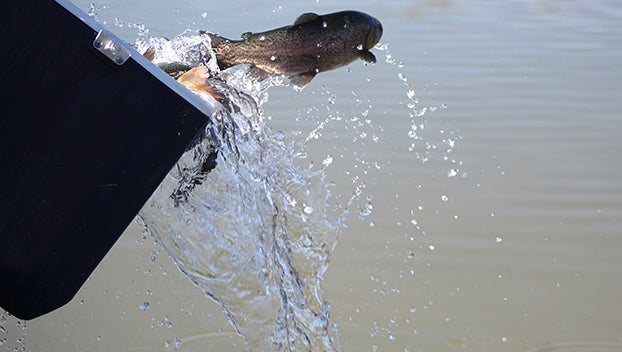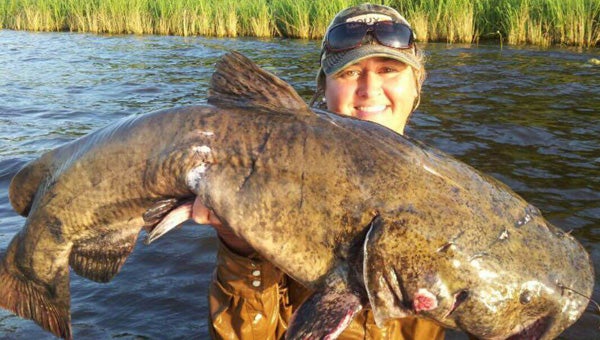Jumping fish causing problems in local waters
Published 12:01 am Sunday, June 26, 2011
NATCHEZ — Anglers and boating enthusiasts need be on the lookout for flying fish when running their boats through local waters.
Asian carp are abundant in the Mississippi River, and any body of water that is connected to the Mississippi is subject to have them, said Mike Wood, director of Inland Fisheries for the Louisiana Department of Wildlife and Fisheries.
One species of Asian Carp is the Silver Carp, and they have a propensity to jump out of the water when startled by boat motors, Wood said.
“They jump, they jump like crazy, and they can be dangerous because they get big,” he said. “They can get up to 50 pounds without a lot of trouble, and something like that in the air (combined with) being in a boat can be a dangerous situation.”
Dennis Riecke, fisheries coordinator for the Mississippi Department of Wildlife, Fisheries and Parks, said this year’s river flood provided ideal conditions for further expansion of Asian carp in the area.
“(The river flood) probably did two things,” Riecke said. “The rising water probably encouraged fish and provided ideal conditions for a good spawn, and it allowed young fish to spread to areas they couldn’t go before because it was dry.
“It allowed fish basically to go anywhere there was flood water. They gained access to Wolf and Broad lakes as well as Bee Lake and Eagle Lake.”
Local anglers like Eddie Roberts and Kevin Smith can testify to the silver carp’s ability to jump.
“I’ve had them run into my head, my back and my boat,” Roberts said. “It scares the daylights out of you when you are motoring along and a 10-pound fish leaps out of the water and smacks you upside the head.”
A flying fish also struck Smith over a year ago when he was fishing on the Tensas River in Clayton, La.
“We were in a 16-foot boat going 20 mph and a fish came up and hit me in the shoulder and landed in the boat,” he said. “They are a species that is slimy, and it slimed the inside of my boat. We haven’t seen anymore, but we learned not to throttle up in that particular river.”
Biologists like Wood and Riecke have concerns about the Asian carp that reach beyond getting hit in the head by one, however.
“As a biologist, there is a concern that exotic or invasive species will displace something that was native to the area that naturally evolved there, and that is the case (with the Asian Carp),” Wood said.
“The Silver Carp eats plankton and are very efficient. That disrupts the food chain because the little native fish eat plankton and the less plankton, the less native fish can be produced.”
Wood and Riecke both said there is not much the Department of Wildlife can do about combating the Asian Carp numbers. Both emphasized public fishing as one of their primary weapons.
“The only thing that can be done is to encourage people to fish for them,” Riecke said. “We hope people will eat them, they are quite tasty even though they don’t look like a desirable fish to eat.”
Wood said Louisiana is focusing on recreational fishing as a tool to attempt to control numbers as well.
“We’ve got people trying to monitor where they are and like to encourage folks to use the fish,” he said.
Wood said one attempt at generating a market for Silver Carp required a name-change for the fish to separate it from the stigma that people have about eating carp.
“If folks would try them they would like them,” Wood said. “They carry the connotation of carp, which is usually negative primarily because the original carp we got were old German Carp.”
Wood said German Carp were considered less than desirable to eat, but Silver Carp (or Silverfin as he now calls them) are actually pretty good.
“At one time we worked in conjunction with Chef Philippe Parola to come up with ways to cook the Silver Carp. We had a taste test and the chef came up with recipes and no one disliked it.”
The Asian Carp problem is a national one, and some of the national management plan revolves around finding a market for the fish as well, Sam Finney, fish biologist for the U.S. Fish and Wildlife Service said.
“There are some mechanical removal methods like shocking them or catching them in nets, but on the scale we’re talking about that isn’t all that realistic,” Finney said. “We people will be interested in marketing the fish for food or dog food. That’s probably in reality one of the more promising things that could take numbers of fish out of the river.”
The biologists all say prevention is key to combating the carp.
“In most cases when you put something non-native in, it has the potential to get out of hand because there are no controls present,” Wood said. “The important thing is to not put something in that doesn’t belong.”
There are four species of Asian Carp considered to be a threat in the U.S. They are the Bighead, Silver, Black and Grass carps. Catfish farmers introduced them in the 60s to eat algae in their ponds.





